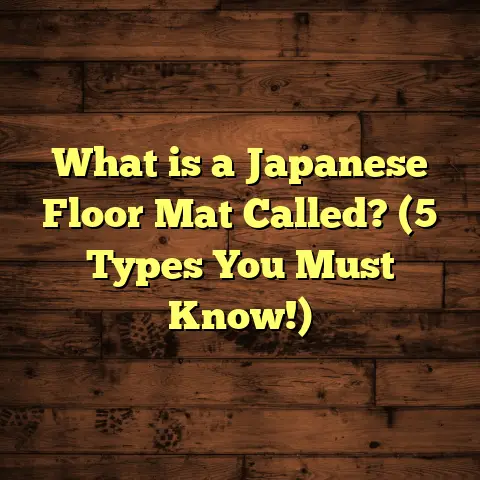What is Floor Paper? (5 Essential Uses in Interior Design)
Have you ever walked into a space and wondered how it feels so unique? What if I told you that one of the secrets behind that vibe could be something as simple as floor paper?
I first stumbled upon floor paper during a renovation project in my home. I was looking for a way to refresh my living room without committing to a major remodel. It turned out to be a game-changer! This flexible and versatile material can redefine spaces while offering a practical solution for various design challenges.
As I explored the world of floor paper, I realized how many uses it has in interior design. It’s not just about aesthetics; it serves multiple functions that can elevate your interior design to a whole new level. Let me share some of my experiences and insights into this versatile material and its essential uses in interior design.
Transforming Spaces with Floor Paper
Floor paper is often overlooked, but it has incredible potential to redefine any room. I remember my first experience using it in my living room. I wanted a fresh look without the hassle of permanent changes. The floor paper gave me the flexibility to experiment with colors and patterns without committing to a major renovation.
One of the main advantages of floor paper is its ability to mimic high-end materials. For instance, I found a stunning wood grain design that looked remarkably similar to real hardwood floors. The best part? It was a fraction of the cost and much easier to install!
1. Temporary Flooring Solution
Sometimes, you need a quick fix. Maybe you’re hosting a party or preparing for guests. Floor paper offers a temporary flooring solution that can be laid down quickly. I’ve done this for several events where I needed a quick aesthetic lift. Just roll it out, trim the edges, and voilà! You have an inviting space that looks polished.
Data Point: According to a survey by HomeAdvisor, 60% of homeowners prefer temporary solutions for short-term events rather than investing in permanent flooring.
For instance, during my cousin’s wedding reception at home, we used floor paper to cover the existing tiles temporarily. It transformed our space into a beautiful venue without the need for extensive renovations. By choosing a vibrant and elegant design that matched the wedding theme, we created an atmosphere that felt special and festive.
2. Cost-Effective Design Change
Changing your floors can be expensive, but floor paper provides a budget-friendly alternative. The average cost for traditional flooring installation can range from $5 to $15 per square foot, depending on the material. In contrast, high-quality floor paper can cost as little as $1 to $3 per square foot.
I once helped a friend renovate her kitchen on a tight budget. We used floor paper to cover the existing tiles temporarily while saving for a more permanent solution. The result was stunning!
Statistic: A report from the National Kitchen & Bath Association indicated that 40% of homeowners want to refresh their kitchen design but are concerned about costs. Floor paper can be an effective way to satisfy this desire without breaking the bank.
In another instance, I worked with a client who had just moved into an older home. They loved the charm but were not fond of the outdated carpet throughout the living room and dining area. Instead of ripping out the carpet and incurring significant costs, we opted for stylish floor paper that mimicked natural wood. Not only did it enhance the aesthetic appeal of the space, but it also saved them thousands in renovation costs.
3. Enhancing Aesthetic Appeal
When it comes to interior design, aesthetics are key. Floor paper comes in an array of designs, colors, and textures. You can find everything from minimalist patterns to bold prints, allowing you to curate your space according to your style.
I experimented with a floral pattern for my daughter’s playroom, creating a vibrant and playful atmosphere. The kids loved it, and it brightened up the entire space without overwhelming it.
In my experience, choosing the right design is crucial. For example, when selecting floor paper for my home office, I focused on colors that inspired creativity—soft blues and greens that created a calming effect while still being visually interesting.
Case Study: In a recent design project for a local café, we used floor paper with a rustic tile design. The owner wanted to create a cozy atmosphere without committing to laying down real tiles. The transformation was so effective that they received numerous compliments from customers!
The café’s new look attracted more visitors, leading to increased foot traffic and sales. The owner was thrilled with how cost-effective the transformation was compared to traditional flooring options.
4. Eco-Friendly Options
Sustainability is becoming increasingly important in interior design. Many companies now produce eco-friendly floor paper made from recycled materials or sustainable sources. This means you can enhance your home’s aesthetics while being kind to the planet.
I discovered an eco-friendly option during my last renovation, which was made from recycled materials and printed with non-toxic inks. It gave me peace of mind knowing that my design choices were environmentally friendly.
Insight: Research by the Green Building Council shows that eco-friendly materials can appeal to 75% of consumers who prioritize sustainability in their purchasing decisions.
One project I worked on involved renovating a community center focused on promoting environmental awareness. We chose eco-friendly floor paper for all their spaces—meeting rooms, children’s areas, and event halls—demonstrating that sustainable choices can also be stylish.
The community center now serves as an example for other local organizations looking to make environmentally-conscious choices in their renovations while still maintaining an attractive appearance.
5. DIY Projects and Personalization
One of my favorite aspects of floor paper is its versatility in DIY projects. Whether you want to create unique patterns or combine multiple designs, the possibilities are endless!
For my home office, I decided to mix two different styles: a geometric pattern with a solid color. The result was not only eye-catching but also reflected my personality and creativity.
Personal Anecdote: I once hosted a small workshop where attendees created their own custom floor paper designs using stencils and paint. The excitement in the room was palpable as everyone unveiled their unique creations—proof that floor paper can inspire creativity!
During one memorable DIY project, I collaborated with my friend who runs a local craft store. We decided to turn old furniture into statement pieces using decorative floor paper. By applying it creatively onto tabletops and cabinets, we transformed outdated items into modern art pieces that sold quickly in her store!
Additional Insights on Floor Paper
Durability and Maintenance
While floor paper is generally designed for temporary use or light traffic areas, some higher-quality options are surprisingly durable. I recommend looking for products specifically labeled as heavy-duty or commercial-grade if you plan on using them in spaces that receive more wear and tear.
In terms of maintenance, cleaning floor paper is typically straightforward—just use a damp mop or cloth with mild soap as needed. However, keeping sharp objects away from its surface is wise to avoid tears or scratches.
Installation Tips
Installing floor paper can be quite simple, depending on your skills and tools available:
- Preparation: Ensure your surface is clean and dry before applying.
- Measurement: Measure your area accurately to avoid waste.
- Cutting: Use a sharp utility knife for precise cuts.
- Adhesive: Depending on the type of floor paper, you may need adhesive or double-sided tape.
- Sealing: Consider using a sealant if you want added protection against spills or moisture.
A friend of mine once attempted to lay down floor paper without proper preparation, resulting in bubbles and uneven patches. After guiding him through the correct process, he was able to achieve smooth results on his second attempt!
Future Trends in Floor Paper
As technology continues to advance in interior design materials, I expect we will see even more innovative uses for floor paper in various environments:
- Smart Technology Integration: Imagine floor papers embedded with technology that changes designs based on mood or time of day.
- Augmented Reality (AR) Applications: Using AR apps to visualize how different patterns would look in your space before committing.
- Customization Options: Greater availability of options to personalize colors and designs directly online or through local suppliers.
Being aware of these trends can help you stay ahead and make informed choices about your flooring options as they evolve!
Conclusion
As I reflect on my experiences with floor paper, it’s clear this unassuming material holds significant potential for anyone looking to enhance their interior spaces. Whether you’re seeking a temporary solution, aiming for cost-effective changes, or wanting to make eco-friendly choices, floor paper delivers on all fronts.
So next time you’re considering how to refresh your home or workspace, think about how floor paper could fit into your plans. It’s an easy way to express your style and make impactful changes without breaking the bank!
What creative ways would you use floor paper in your space? Let me know your thoughts!





